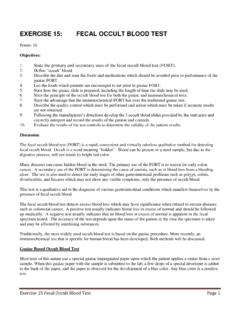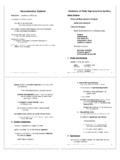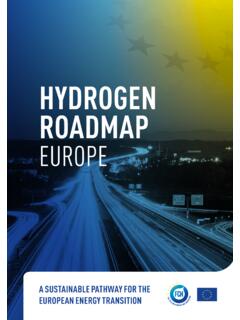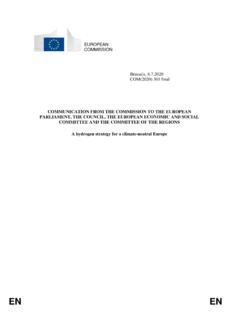Transcription of Science Lesson Plan Example – Part I Objective & Student ...
1 Science Lesson Plan Example part I Objective & Student Expectation: The students will be able to classify the changes of state matter undergoes when given a description of the shape and volume. The students will be able to describe the change of state matter undergoes when given the name. The students will be able to identify examples of each change of state when given either a description or the name of a change of state. Concepts Changes of state of matter: melting, evaporation, condensation, freezing, sublimation, deposition. Resources and Materials Computer lab - One per Student projector projector screen chalk and board (if needed) CHANGES OF STATE OF MATTER Vocabulary Matter - anything that has mass and takes up space. States of Matter - solid, liquid, gas, plasma Solid - has definite shape, definite volume (ex.)
2 Rock) Liquid - has indefinite shape, definite volume (ex. water) Gas - has indefinite shape, indefinite volume (ex. air) Teaching (Input, Modeling & Check for Understanding) The teacher inputs information about the states of matter by reviewing vocabulary, and introducing notes on the topic. Students take notes detailing information presented. Input: Discussion Scientists study different changes that shape the world around us. Let s take a closer look at the states of matter to see how those changes shape the world around us. Can someone give an Example of a change in states of matter? (Guiding Question) Teacher listens to Student comments. Great we re on the right track to understanding changes in states of matter. Teacher reads Student Objective and expectation to further focus Student s attention on the Objective , and begins explaining the Objective .
3 Teacher should pause to answer Student questions during instruction. The following are notes that students will take over the topic states of matter. The teacher explains: When something such as water turns from being water to being ice, it is called a change of state. There are different changes that can take place. Water, for Example , can change from water to ice, which is called freezing. Freezing is what happens when a liquid changes to a solid. Water can change from ice to water, which is called melting. Melting is what happens when a solid changes to a liquid. Water can also change from a water to steam, which is called evaporation. Evaporation is what happens when a liquid changes to a gas. Water can change from steam back to water, which is called condensation.
4 Condensation occurs when gas changes into a liquid. There are some substances which can go from being a solid, directly to the gas state, which is called sublimation. Solid carbon dioxide, commonly known as Dry Ice, bypasses the liquid state altogether when it changes to a gas. The last change of state is matter going from a gas, directly to the solid state, which is called deposition. Water vapors in the air during winter fall in the form of snow, a solid. **Check for Understanding: The teacher will check for understanding by using matching game built into the presentation. On the screen, students will see vocabulary words and/or phrases from the notes that were presented. Students will separate into two teams, and compete to earn the most points by answering the questions.
5 ** Lesson Plan Example part II Objective & Student Expectation: The students will be able to classify the changes of state matter undergoes when given a description of the shape and volume. The students will be able to describe the change of state matter undergoes when given the name. The students will be able to identify examples of each change of state when given either a description or the name of a change of state. Concepts Changes of state of matter: melting, evaporation, condensation, freezing, sublimation, deposition. Resources and Materials Computer lab - One per Student projector projector screen chalk and board (if needed) Vocabulary Matter - anything that has mass and takes up space. States of Matter - solid, liquid, gas, plasma Solid - has definite shape, definite volume (ex.)
6 Rock) Liquid - has indefinite shape, definite volume (ex. water) Gas - has indefinite shape, indefinite volume (ex. air) Review The teacher reviews the previous day s instruction (changes in the states of matter) to further build back ground knowledge, and an understanding of the concept. Teaching (Input, Modeling & Check for Understanding) The teacher inputs information about the causes of changes in the states of matter by reviewing vocabulary, and notes from the previous day s instruction on the topic. Students take notes detailing information presented. Input: Discussion Now, let s take a closer look at the causes of changes in the states of matter. Can any one infer some causes in states of matter? (Guiding Question) Teacher listens to Student comments to check for understanding.
7 Next, teacher reads Student Objective and expectation to further focus Student s attention on the causes of the changes in the states of matter. CAUSE OF CHANGES: energy . energy is either lost or gained during a change of state. When energy is applied to a solid, the tightly packed particles of matter begin to move around, flowing over each other. The result is the movement of liquid. The shape becomes indefinite. The volume, however, does not change, because the particles are still part of one another. When energy is applied to a liquid, the particles that make up a liquid begin to move about so rapidly, that they can no longer hold themselves together. The result is the movement of a gas. The shape is indefinite, and the volume becomes indefinite. The reverse happens to gas when energy is taken away.
8 Water vapor, for Example begins to liquify as it cools. Remember the cool mornings when fog is dense and close to the ground? What happens? Dewdrops form. The water vapors in the air cool to form liquid drops on grass. When energy is taken away from liquid; the particles in the liquid slow down to low movement. The resulting solid, has definite shape and definite volume. Teacher gives more examples. Check for Understanding: The teacher will check for understanding by showing pictures of different objects that could change states. Students will be asked to explain how these objects possibly changed into their current state, and how they could change to another state of matter. Student will receive eagle bucks for participating in class discussion. Guided Practice: Students are separated into groups for a mini-lab assignment.
9 Each group is given a box with an object. The task is to hypothesize how the object(s) can be changed from one state to another, what element would be needed to change the object, and if it would be a permanent change or not. Students must work as a group to accomplish the task, and complete a detailed report to turn into the teacher. The teacher circulates around the room to check for understanding during the task. Independent Practice: Students read and answer four Science scenario questions for homework to further extend knowledge of the causes of changes in matter. Lesson Plan Example part III Objective & Student Expectation: The students will be able to classify the changes of state matter undergoes when given a description of the shape and volume. The students will be able to describe the change of state matter undergoes when given the name.
10 The students will be able to identify examples of each change of state when given either a description or the name of a change of state. Concepts Changes of state of matter: melting, evaporation, condensation, freezing, sublimation, deposition. Resources and Materials Computer lab - One per Student projector projector screen chalk and board (if needed) Vocabulary Matter - anything that has mass and takes up space. States of Matter - solid, liquid, gas, plasma Solid - has definite shape, definite volume (ex. Rock) Liquid - has indefinite shape, definite volume (ex. water) Gas - has indefinite shape, indefinite volume (ex. air) Review The teacher reviews the previous day s instruction (changes in states of matter & causes of changes in states of matter). Teaching (Input, Modeling & Check for Understanding) Input, Modeling & Check for Understanding: The teacher reviews the concept by facilitating a class discussion using the Science scenario assigned for homework.
















